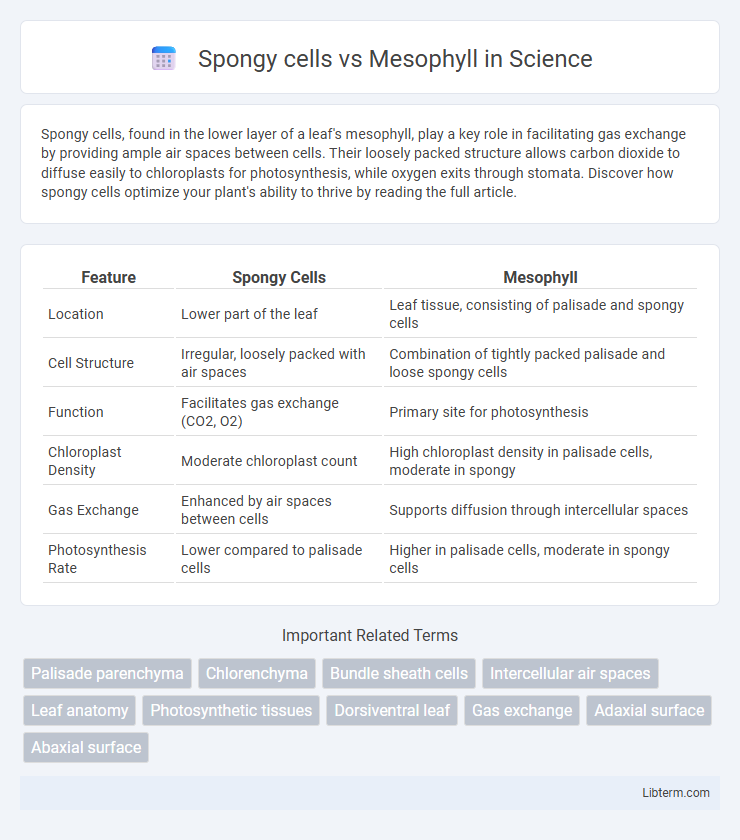Spongy cells, found in the lower layer of a leaf's mesophyll, play a key role in facilitating gas exchange by providing ample air spaces between cells. Their loosely packed structure allows carbon dioxide to diffuse easily to chloroplasts for photosynthesis, while oxygen exits through stomata. Discover how spongy cells optimize your plant's ability to thrive by reading the full article.
Table of Comparison
| Feature | Spongy Cells | Mesophyll |
|---|---|---|
| Location | Lower part of the leaf | Leaf tissue, consisting of palisade and spongy cells |
| Cell Structure | Irregular, loosely packed with air spaces | Combination of tightly packed palisade and loose spongy cells |
| Function | Facilitates gas exchange (CO2, O2) | Primary site for photosynthesis |
| Chloroplast Density | Moderate chloroplast count | High chloroplast density in palisade cells, moderate in spongy |
| Gas Exchange | Enhanced by air spaces between cells | Supports diffusion through intercellular spaces |
| Photosynthesis Rate | Lower compared to palisade cells | Higher in palisade cells, moderate in spongy cells |
Introduction to Leaf Anatomy
Spongy cells are a type of mesophyll tissue found in the lower part of the leaf, characterized by loosely packed cells with large air spaces to facilitate gas exchange. Mesophyll is broadly divided into palisade and spongy mesophyll, where palisade cells are densely packed and primarily responsible for photosynthesis, while spongy cells support the process by allowing diffusion of oxygen, carbon dioxide, and water vapor. Understanding the structural differences between spongy cells and the overall mesophyll layer is essential for studying leaf anatomy and its role in photosynthesis and transpiration.
Overview of Mesophyll Structure
The mesophyll is a critical tissue in plant leaves, consisting mainly of two cell types: spongy cells and palisade cells. Spongy cells are loosely arranged with large air spaces to facilitate gas exchange, while palisade cells are densely packed to maximize photosynthesis through chloroplast concentration. This dual structure optimizes both light absorption and carbon dioxide diffusion, essential for efficient photosynthesis in most vascular plants.
Defining Spongy Cells
Spongy cells are a type of mesophyll cell located beneath the palisade layer in plant leaves, characterized by their loose arrangement and large air spaces to facilitate gas exchange. These cells contain chloroplasts but are less densely packed with chlorophyll compared to palisade mesophyll cells, prioritizing the diffusion of carbon dioxide and oxygen. Their structural specialization supports photosynthesis while maintaining efficient internal leaf aeration.
Palisade vs Spongy Mesophyll
Palisade mesophyll consists of tightly packed, elongated cells rich in chloroplasts, optimizing light absorption for photosynthesis in leaves. Spongy mesophyll features loosely arranged cells with large air spaces that facilitate gas exchange and diffusion of carbon dioxide to palisade cells. The structural difference between palisade and spongy mesophyll directly supports their distinct roles in photosynthetic efficiency and gaseous exchange within the leaf.
Functions of Spongy Cells
Spongy cells, located in the lower part of the leaf mesophyll, primarily facilitate gas exchange by creating air spaces that allow oxygen, carbon dioxide, and water vapor to diffuse efficiently. These cells contain fewer chloroplasts than palisade mesophyll cells, optimizing their role in respiration and photosynthesis by ensuring gases reach photosynthetic tissues. Their irregular shape and loose arrangement maximize surface area for gas diffusion while maintaining leaf structural flexibility.
Role of Mesophyll in Photosynthesis
Mesophyll cells in leaves are the primary site of photosynthesis, containing chloroplasts that capture light energy to convert carbon dioxide and water into glucose. They are divided into two types: palisade mesophyll, which is densely packed for maximum light absorption, and spongy mesophyll, which has air spaces to facilitate gas exchange. Spongy cells support photosynthesis by allowing carbon dioxide to diffuse through intercellular spaces to reach the chloroplast-rich palisade cells.
Gas Exchange in Spongy Cells
Spongy cells, a component of the mesophyll in leaves, play a crucial role in gas exchange by providing large intercellular air spaces that facilitate the diffusion of oxygen, carbon dioxide, and water vapor. Unlike the densely packed palisade mesophyll, spongy mesophyll cells are loosely arranged, maximizing surface area for gas circulation essential for photosynthesis and respiration. This structural adaptation enhances the movement of gases between the leaf interior and the external environment, optimizing the plant's overall gas exchange efficiency.
Comparative Cellular Arrangement
Spongy cells exhibit a loose, irregular arrangement with large intercellular air spaces facilitating gas exchange, while mesophyll refers broadly to the inner leaf tissue comprising both palisade cells, tightly packed for maximum light absorption, and spongy cells. The spongy mesophyll's porous structure contrasts sharply with the dense, columnar palisade mesophyll, optimizing their respective roles in photosynthesis and respiration. This comparative cellular arrangement enhances overall leaf efficiency by balancing light capture and gas diffusion within the leaf's internal anatomy.
Adaptations in Different Plant Types
Spongy cells, characterized by their loose arrangement and large intercellular spaces, facilitate efficient gas exchange, adapting well to plants in humid environments where rapid oxygen and carbon dioxide diffusion is essential. In contrast, mesophyll, particularly palisade mesophyll cells, are densely packed with chloroplasts, optimizing photosynthesis in plants exposed to high sunlight levels. Xerophytes exhibit modifications such as thickened cell walls in spongy mesophyll cells to reduce water loss, while hydrophytes feature highly developed spongy tissue to maximize buoyancy and gas storage.
Conclusion: Importance in Plant Physiology
Spongy cells, a component of the mesophyll, play a critical role in facilitating gas exchange due to their loose arrangement and large intercellular spaces. Mesophyll, encompassing both spongy and palisade cells, is essential for efficient photosynthesis as it houses chloroplasts that capture light energy. The complementary functions of spongy cells and mesophyll tissues are vital for optimizing photosynthetic efficiency and maintaining overall plant health.
Spongy cells Infographic

 libterm.com
libterm.com